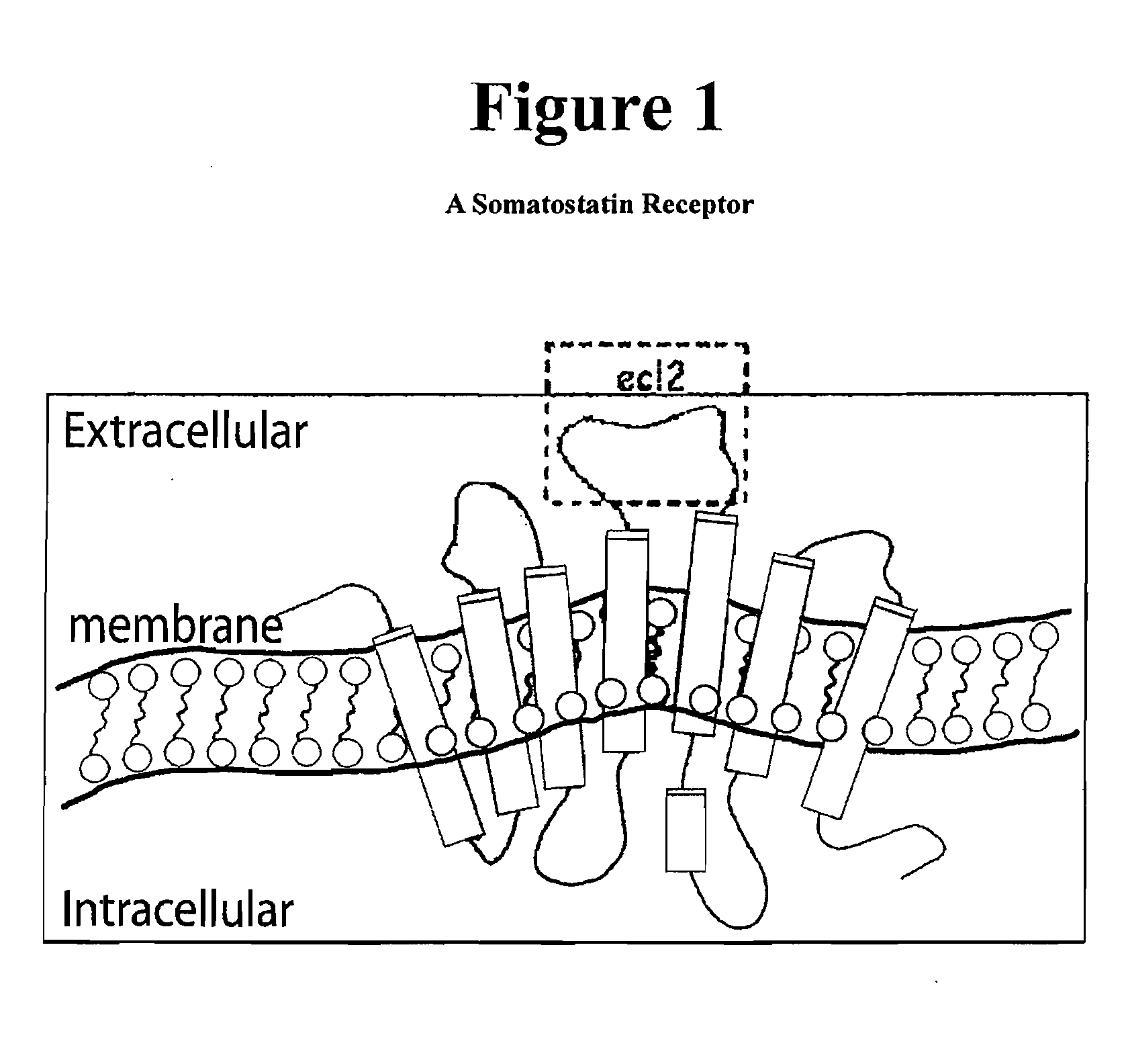Antibodies to human somatostatin receptor and methods of use
a human somatostatin receptor and anti-sstr technology, applied in the field of anti-sstr antibodies to human somatostatin receptors and methods of use, can solve the problems of not removing the threat of metastasis, not providing detailed information about the expression levels of individual hsstr subtypes on neuroendocrine tumors, and commercially available anti-sstr antibodies are generally inferior in quality. , to achieve the effect of improving th
- Summary
- Abstract
- Description
- Claims
- Application Information
AI Technical Summary
Benefits of technology
Problems solved by technology
Method used
Image
Examples
example 1
Production of Polyclonal Antibodies Directed to hSSTR Subtypes
[0148]Various peptides of 14 amino acid residues in length, and derived from the ecl2 of each of hSSTR subtypes 1, 2, 3, 4 and 5, were used to generate hSSTR subtype-specific antibodies. The antigens were:
hSSTR1:TVACNMIMPEPAQR;(SEQ ID NO: 3)hSSTR2:QWGRSSCTINWPGE(SEQ ID NO: 1)hSSTR3:PRGMSTCHMQWPEP(SEQ ID NO: 4)hSSTR4:DTRPARGGQAVACN(SEQ ID NO: 5)andhSSTR5:DVQEGGTCNASWPE(SEQ ID NO: 2)
[0149]The peptides represented by SEQ ID NOs: 1-5 were conjugated to keyhole limpet hemocyanin (KLH). Lysine was added at the N-terminus of the peptides to couple the peptides to KLH by amino group conjugation using glutaraldehyde. These peptide antigens (50-500 μg) were diluted in 1 ml sterile saline and 1 ml of Complete Freund's Adjuvant (CFA). The peptide antigen and adjuvant were mixed thoroughly to form a stable emulsion. For subsequent preparation of antigen for injection into rabbits, Incomplete Freund's Adjuvant (IFA) was used. IFA was u...
example 2
Anti-hSSTR Subtype 2, Anti-hSSTR Subtype 3, Anti-hSSTR Subtype 4, and Anti-hSSTR Subtype 5 Polyclonal Antibodies of the Present Invention are Subtype Specific
[0150]Recombinant proteins with the ecl2 domain from hSSTR subtypes 1, 2, 3, 4 or 5 were attached to the C-terminus of mouse dihydrofolate reductase (mDHFR molecular weight=28 KD). These recombinant proteins were used in Western blots to test subtype specificity for the hSSTR antibodies produced according to Example 1 above. Whole cell lysates from NIH-3T3 were also included in order to test for non-specific binding by the antibodies. Each of four blots was probed with any one of the hSSTR subtype 2, hSSTR subtype 3, hSSTR subtype 4 or hSSTR subtype 5 antibodies. The results of the Western blot experiment showed that all antibodies are subtype specific. The antibody prepared against ecl2 from hSSTR subtype 1 was also tested, but was determined to lack hSSTR subtype 1 affinity because it did not bind to hSSTR-ecl2 subtype 1 reco...
example 3
Anti-hSSTR Subtype 2, Anti-hSSTR Subtype 3 and Anti-hSSTR Subtype 5 Antibodies Can Detect Membrane Surface Receptors on Cells
[0152]BON cells were used to test the ability of the anti-hSSTR antibodies to recognize endogenous receptors on the surface of a carcinoid cancer cell line. BON cells have been shown to express endogenous hSSTR subtype 1, hSSTR subtype 2, hSSTR subtype 3, and hSSTR subtype 5, but not hSSTR subtype 4 (E. Ludvigsen et al., Med Oncol 21 (3), 285 (2004)). The ability of the antibodies to bind to cell surface receptors can indicate their diagnostic and / or therapeutic potential. BON cells (human carcinoid cells) were seeded, grown and maintained in F12 HAM (Invitrogen, Cat#31765035) / D-MEM (Invitrogen, Cat#10567-014) (50 / 50) in 10% certified fetal bovine serum (FBS) (Invitrogen, Cat#16000-044). In some of the experiments described herein, 48 hours prior to experimentation BON cells were washed 2 times using 10 ml D-PBS, and maintained in F12 HAM / DMEM cell growth medi...
PUM
| Property | Measurement | Unit |
|---|---|---|
| Therapeutic | aaaaa | aaaaa |
| Chemotherapeutic properties | aaaaa | aaaaa |
Abstract
Description
Claims
Application Information
 Login to View More
Login to View More - R&D Engineer
- R&D Manager
- IP Professional
- Industry Leading Data Capabilities
- Powerful AI technology
- Patent DNA Extraction
Browse by: Latest US Patents, China's latest patents, Technical Efficacy Thesaurus, Application Domain, Technology Topic, Popular Technical Reports.
© 2024 PatSnap. All rights reserved.Legal|Privacy policy|Modern Slavery Act Transparency Statement|Sitemap|About US| Contact US: help@patsnap.com










